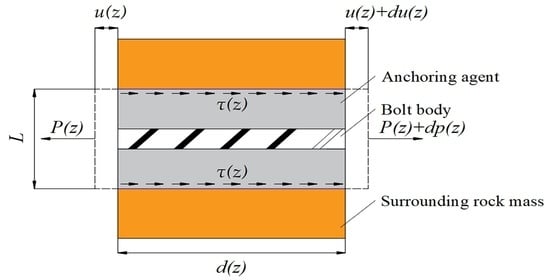Full-Stress Anchoring Technology and Application of Bolts in the Coal Roadway
Abstract
:1. Introduction
2. Load Transfer Mechanism of the Anchoring Section of Bolts
2.1. Full-Stress Anchoring
2.2. Mechanical Relationship Model of the Bolt-Drawing Anchoring Interface
2.3. Load Transfer Law of the Anchoring Section
3. Full-Stress Anchoring Experiment of Bolts
3.1. Experimental Device for the Prestressed Loading of the Bolt
3.1.1. Loading System
CML300 Torque Wrench
Manual Hydraulic Oil Pump
3.1.2. Anchoring System
3.1.3. KJ327-F Strain Data Collector
3.1.4. Comprehensive Parameter Tester of CD-4 Bolt
3.1.5. Load Tester of the GDP60 Bolt
3.1.6. Experimental Bolt
3.2. Prestressed Loading Experiment Scheme
- (1)
- 8 mm rebar bolts with the same body parameter of mm were taken. We randomly divided two groups into four groups, and the grouping numbers were I, II, III, and IV in sequence. In the four groups, the bolts were numbered 1 and 1+, 2 and 2+, 3 and 3+, and 4 and 4+.
- (2)
- The bolts of groups I-IV were separately applied with pre-tightening forces of 10, 20, 30, and 40 kN, and the bolts numbered 1, 2, 3, and 4 were tightened with six chucks and then tensioned. We then simulated the method of applying the pre-tightening force of the traditional bolts, and the bolts numbered 1+, 2+, 3+, and 4+ were first tightened with three chucks at the end of the bolt and tensioned. Then, we tightened the remaining three chucks to simulate the pre-tightening force application method of the full-stress anchoring bolt.
- (3)
- Six sets of strain gauges were posted at equal intervals on each bolt. The corresponding measuring point numbers were 1#, 2#, 3#, 4#, 5#, and 6#, with two strain gauges in each group (see Figure 13). The strain data collector collected the data and sent them back to the computer to calculate the axial force of bolts.
3.3. Analysis of Axial Force Monitoring Data of Bolts
- (1)
- For the two anchoring methods of traditional prestressed anchoring and full-stress anchoring, under the same anchoring method, the axial force values corresponding to the same bolt from the anchoring tail end measuring point 1# to the beginning measuring point 6# were gradually reduced, which conformed to the load transfer law of the anchoring section of bolts obtained in the theoretical analysis.
- (2)
- The axial force values of bolts in groups I~IV at the same position under the same prestressed anchoring method increased with the increased initial preload. It showed that appropriately increasing the pre-tightening force could increase the axial force of bolts under the same conditions and enhance the pre-stress transmission of the anchoring section. However, with an increased initial preload, the axial force loss rate of bolts with a high preload was higher under the same transmission length.
- (3)
- Comparing the axial force values of the two different anchoring methods in the same position of the bolts in groups I-IV, the axial force values of 1+, 2+, 3+, and 4+ were greater than those of 1, 2, 3, and 4. The difference between the axial forces of the former and the latter showed a “small–large–small” change rule, indicating that the anchoring effect of the anchoring section applied in the subsequent sequence was to control the axial force loss of the bolts in the middle of the anchoring section. That is to say, the significance in actual engineering was that the retarded anchorage section of the anchorage section of bolts lagged behind the quick-setting anchorage section of the bolt end. It was able to control the axial-force loss in the middle of the anchorage section, thereby improving the prestress diffusion of bolts. Meanwhile, the pre-stress transmission of the full-stress pre-tightening force application method of bolts was better than that of the traditional method.
4. FLAC3D Numerical Simulation Analysis of Anchoring Length on the Full-Stress Anchoring Effect of Bolts
4.1. FLAC3D Numerical Simulation Model Material Parameters
4.2. Simulation Schemes of Different Anchorage Lengths
- (1)
- Regardless of the initial ground stress, only the pre-tightening force was applied to bolts.
- (2)
- The boundary displacement of the model was restricted to 0, and the anchoring body was always in the elastic deformation stage when the preload was applied.
- (1)
- The initial pre-tightening force of the control bolts was 60 kN, and the mechanical parameters of the anchored surrounding rock using mudstone remained unchanged.
- (2)
- Two anchoring methods were used, namely the full-stress anchoring method and the traditional pre-stressed anchoring method of bolts. The latter was the control test group of the former.
- (3)
- The length of the anchoring section was controlled to meet the requirements of lengthening anchoring, and the designed anchoring lengths were 0.9, 1.3, 1.7, and 2.1 m, respectively.
- (4)
- The stress distribution of the surrounding rock in the YY direction was recorded under different anchorage lengths. The established numerical simulation model should reach the operational balance and then stop after starting the operational command to meet the precise experimental requirements.
4.3. Analysis of the Full-Stress Anchoring Effect of Bolts under Different Anchoring Lengths
- (1)
- Comparing Figure 15a,c,e,g obtained under the traditional prestressed anchoring method of bolts, the stress value of the tensile stress concentration area at the end of the anchoring section gradually decreases as the anchoring length increases. Therefore, increasing the anchoring length is beneficial to the quality of bolt construction and reducing the damage in the anchored section.
- (2)
- Comparing Figure 15b,d,f,h, the pre-stress diffusion range gradually decreases as the anchoring length increases, and the control range of the surrounding rock is gradually reduced. However, after the anchorage length increases, the stress value of the compressive stress zone is higher than that of the shorter anchoring length, with stronger control over the surrounding rock. Therefore, the anchorage length should be increased to control the rock stratum. At this time, the key lies in the time difference between quick- and slow-setting anchoring sections in establishing the full-stress anchoring method of bolts. Before the retarded section is solidified, a pre-tightening force is applied to bolts in time to give full play to the advantages of the short anchorage length and the larger pre-stress spreading range, thus expanding the control range of the surrounding rock. When the retarded section is solidified, the long anchor section formed by combining the quick-set anchor section and the retarded anchor section can keep the stress value of the compressive stress zone high and enhance the control strength of the surrounding rock.
- (3)
- Comparing (a) and (b), (c) and (d), (e) and (f), (g) and (h), under the same pre-tightening force, the same anchoring length, the same anchoring surrounding rock lithology, and the same bolt parameters, the full-stress anchoring method of bolts has a wider diffusion range of pre-stress and a larger effective continuous compressive stress area than the traditional pre-stressed anchoring method of bolts. Therefore, it has been proved once again that under the same conditions, the full-stress anchoring method of bolts has better control over the surrounding rock than the traditional pre-stressed anchoring method.
5. Engineering Application of the Full-Stress Anchoring Technology of Bolts
5.1. Engineering Method to Realize the Full-Stress Anchoring Technology of Bolts
- (1)
- The initial pre-tightening force of the anchor rod was increased and an appropriate length of bolt was selected. The key to full-prestressed anchoring of bolts is that the full length of the bolt has an effective pre-stress distribution. Increasing the initial pre-tightening force can increase the pre-stress value along the entire length of the bolt. The choice of length should be combined with the mechanical characteristics and development of the surrounding rock. For rock strata exhibiting low mechanical strength, severe deformation and damage, and well-developed joints and fissures, the length of the bolts must be increased, so the ends of the bolts can be anchored at a position where the rock strata has good integrity to ensure the restricted expansion of the weak rock stratum area.
- (2)
- Synergistic use of quick- and slow-setting anchoring agents with different coagulation rates. The bolt driller was used to construct the bolt hole, and the generated cuttings were removed from the drill hole. Firstly, the quick-setting anchoring agent was placed in the deep part of the borehole. After the slow-setting anchoring agent was placed behind the quick-setting anchoring agent, the bolt was inserted for stirring. After the quick-setting anchoring agent was coagulated, the pre-tightening force was applied to the entire bolt when the retarding anchoring agent had not coagulated. Thereby, the prestressing range increased, and a larger range of effective compressive stress thickness formed. The anchoring agent filled the gap between the bolt body and the surrounding rock. Bonding the bolt body and the borehole wall can improve the sensitivity of the bolt body to the deformation and separation of the surrounding rock, thereby restraining the separation and sliding of the surrounding rock in a timely manner.
- (3)
- The total anchorage length of the anchorage section of bolts was increased and the total anchorage length was maintained to meet the requirements of extended anchorage length. In the full-stress anchoring method of bolts, the total anchoring length was the sum of the anchorage length of the quick- and slow-setting sections. After increasing the total anchorage length, the difference in the setting time of the anchoring agent between the quick-setting section and the slow-setting section was used to apply the pre-tightening force to bolts. This enabled us to expand the prestress distribution range and maintain a high prestress value, which enhanced the control range and control strength of the bolts on the surrounding rock.
- (4)
- The row spacing between bolt supports in the full-stress anchoring mode was increased. Under the full-stress anchoring method, the shape of the pre-stress range formed by anchoring the surrounding rock with a single bolt was similar to shape “∩”, which was better than that of the traditional pre-stressed anchoring method. The row spacing between bolt supports could be increased to form a continuous, thick, pre-stressed squeeze zone between the bolts, thus realizing the full-stress anchoring technology of bolts to control the surrounding rock of large-area and large-span roadways.
5.2. Mining Conditions
5.3. Full-Stress Anchoring Support Plan of Bolts
- (1)
- One roll of CK2350 and one roll of K2370 resin anchoring agent were used to replace the original two rolls of K2370 during the process of anchoring the roof and bolts in the roadway. In the construction of the bolts, CK2350 and K2370 were inserted into the borehole in turn. The difference in the setting time of the two anchoring agents was used to apply pre-tightening force to the anchor rod over time, thus spreading the pre-stress to the full length of the anchor rod.
- (2)
- The return-air roadway of working face 3204 belonged to a roadway with a strong dynamic pressure. To improve the control effect of bolts on the surrounding rock, bolts with a specification of mm were used to replace the original mm while anchoring the roof and bolts of the roadway, and the pre-tightening force of the bolts increased from 60 to 80 kN to improve the resistance performance of bolt support. The roof of the roadway adopted an anchor rope with a specification of mm and two rolls of CK2350 and three rolls of K2370. The anchoring method was the same as the full-stress anchoring method of bolts, which anchored the roadway roof.
- (3)
- The full-stress anchoring method of bolts was adopted to increase the row spacing between bolts and anchor cables. The row distance between the roof and side bolts of the roadway increased from to mm, and the row distance between the roof anchor cables increased from to mm. This measure also increased the speed of supporting the surrounding rock of the roadway.
5.4. Roadway Deformation Monitoring
5.5. Application Renderings
6. Conclusions
- (1)
- The mechanical equation based on the axial force and the deformation of the micro-element was established by establishing the mechanical relationship model of the bolt-drawing and anchoring interface and the force of the micro-element of the anchoring section of bolts. Theoretical calculations were used to obtain the distribution formulas of the bolt axial force and shear stress as well as the law of load decline transfer of the bolt axial force and shear stress in the anchoring section of bolts.
- (2)
- For the full-stress anchoring method of bolts, increasing the initial pre-tightening force could increase the axial force under the same conditions and enhance the pre-stress transmission effect of the anchoring section. However, with the increased initial preload, the axial force loss rate of bolts with high preload was higher under the same transmission length.
- (3)
- The retarded anchoring section in the full-stress anchoring method could reduce the axial-force loss of bolts in the middle of the anchor section and improve the diffusion effect of the prestress in the surrounding rock. The key to the full-stress anchoring method of bolts was to use the difference in setting time between quick- and slow-setting anchoring sections and to apply pre-tensioning force to the bolts over time after the quick-setting anchoring section was set. Under the same conditions, the full-stress anchoring method of bolts had better control over the surrounding rock than the traditional pre-stressed anchoring method of bolts.
- (4)
- According to the deformation monitoring data of the return-air roadway in coal seam 2 of the Taitou coking coal mine, after applying the full-stress anchoring technology of bolts, the roadway deformation was controlled for a maximum displacement of the roof and floor of 42 mm, and the maximum displacement on both coal sides was 86 mm. The stability of the surrounding rock of the roadway was greatly improved, and the impact on mining was also controlled. The engineering method to realize the full-stress anchoring technology of bolts was to increase the initial pre-tightening force, select an appropriate length, and place the end of the bolt body in a stable rock stratum to limit the expansion of the weak rock formation area. Furthermore, synergistic use of quick-setting anchoring agents and slow-setting anchoring agents was carried out with different coagulation rates, and the total anchorage length of the anchoring section of bolts was increased while maintaining the total anchorage length to meet the requirements of the extended anchorage length. Finally, the row spacing between bolt supports was increased in the full-stress anchoring mode.
- (5)
- According to the deformation monitoring data of the return-air roadway in No. 2 coal seam of the Taitou Coking Coal Mine, the deformation of the roadway after the application of the full-stress anchoring technology scheme of bolts was controlled with a maximum moving distance of the roof and floor of 42 mm and a maximum displacement on both coal sides of 86 mm. Compared with the original support technology, the value for the roof and floor was reduced by 158 mm, and that of the left and right coal sides was reduced by 244 mm. The bolt full-stress anchoring and supporting technology greatly improved the stability of the surrounding rock of the roadway and controlled the influence of mining. The full-stress anchoring technology of bolts was conducive to controlling the stability of the surrounding rock of the roadway, rationally using supporting materials, increasing the speed of roadway support, and realizing safe and efficient production in coal mines.
Author Contributions
Funding
Institutional Review Board Statement
Informed Consent Statement
Data Availability Statement
Conflicts of Interest
References
- Hou, C.J.; Wang, X.Y.; Bai, J.B.; Meng, N.K.; Wu, W.D. Basic theory and technology study of stability control for surrounding rock in deep roadway. J. China Univ. Min. Technol. 2021, 50, 1–12. [Google Scholar]
- Xie, Z.Z.; Zhang, N.; Han, C.L.; An, Y.P. Research on principle and application of roof thick layer cross-boundary anchorage in coal roadways. Chin. J. Rock Mech. Eng. 2021, 40, 1195–1208. [Google Scholar]
- Liu, C.C.; Zhan, Q.J.; Yang, L.; Zheng, X.G.; Li, P.; Niaz, M.S. Recognition of interface and category of roadway roof strata based on drilling parameters. J. Pet. Sci. Eng. 2021, 204, 108724. [Google Scholar] [CrossRef]
- Yu, Y.; Lu, J.F.; Chen, D.C.; Pan, Y.X.; Zhao, X.Q.; Zhang, L.Y. Study on the stability principle of mechanical structure of roadway with composite roof. Minerals 2021, 11, 1003. [Google Scholar] [CrossRef]
- Zhao, G.M.; Liu, C.Y.; Meng, X.R.; Wang, C. The composite anchorage bearing structure in high stress roadway and its load-bearing effect. J. Min. Saf. Eng. 2021, 38, 68–75. [Google Scholar]
- Wu, P.; Chen, L.; Li, M.; Wang, L.; Wang, X.F.; Zhang, W. Surrounding rock stability control technology of roadway in large inclination seam with weak structural plane in roof. Minerals 2021, 11, 881. [Google Scholar] [CrossRef]
- Yu, Y.; Wang, X.Y.; Bai, J.B.; Zhang, L.Y.; Xia, H.C. Deformation mechanism and stability control of roadway surrounding rock with compound roof: Research and applications. Energies 2020, 13, 1350. [Google Scholar] [CrossRef] [Green Version]
- Wang, D.; Jiang, Y.J.; Sun, X.M.; Luan, H.J.; Zhang, H. Nonlinear large deformation mechanism and stability control of deep soft rock roadway: A case study in China. Sustainability 2019, 11, 6243. [Google Scholar] [CrossRef] [Green Version]
- Gao, R.; Xia, H.C.; Fang, K.; Zhang, C.W. Dome roof fall geohazards of full-seam chamber with ultra-large section in coal mine. Appl. Sci. 2019, 9, 3891. [Google Scholar] [CrossRef] [Green Version]
- Zhai, X.X.; Huang, G.S.; Chen, C.Y.; Li, R.B. Combined supporting technology with bolt-grouting and floor pressure-relief for deep chamber: An underground coal mine case study. Energies 2018, 11, 67. [Google Scholar] [CrossRef] [Green Version]
- An, Y.P.; Zhang, N.; Zhao, Y.M.; Xie, Z.Z. Field and numerical investigation on roof failure and fracture control of thick coal seam roadway. Eng. Failure. Anal. 2021, 128, 105594. [Google Scholar] [CrossRef]
- Yuan, X.; Yang, S.S. Interaction principle of rock-bolt structure and rib control in large deformation. Arch. Min. Sci. 2021, 66, 227–248. [Google Scholar]
- Cao, J.C.; Zhang, N.; Wang, S.Y.; Qian, D.Y.; Xie, Z.Z. Physical model test study on support of super pre-stressed anchor in the mining engineering. Eng. Failure. Anal. 2020, 118, 104833. [Google Scholar] [CrossRef]
- Qi, X.Y.; Wang, R.J.; Mi, W.T.; Wen, Z.J. Failure characteristics and control technology of surrounding rock in deep coal seam roadway with large dip angle under the influence of weak structural plane. Adv. Civ. Eng. 2020, 2020, 1–17. [Google Scholar]
- Xu, Y.; Pan, K.; Zhang, H. Investigation of key techniques on floor roadway support under the impacts of superimposed mining: Theoretical analysis and field study. Environ. Earth Sci. 2019, 78, 436. [Google Scholar] [CrossRef]
- Wu, G.; Chen, W.; Jia, S.; Tan, X.; Zheng, P.; Tian, H.; Rong, C. Deformation characteristics of a roadway in steeply inclined formations and its improved support. Int. J. Rock Mech. Min. Sci. 2020, 130, 104324. [Google Scholar] [CrossRef]
- Kang, H.P. Seventy years development and prospects of strata control technologies for coal mine roadways in China. Chin. J. Rock Mech. Eng. 2021, 40, 1–30. [Google Scholar]
- Kang, H.P.; Fan, J.M.; Gao, F.Q.; Zhang, H. Deformation and support of rock roadway at depth more than 1000 meters. Chin. J. Rock Mech. Eng. 2015, 34, 2227–2241. [Google Scholar]
- Kang, H.P.; Xu, G.; Wang, B.M.; Wu, Y.Z.; Jiang, P.F.; Pan, J.F.; Ren, H.W.; Zhang, Y.J.; Pang, Y.H. Forty years development and prospects of underground coal mining and strata control technologies in China. J. Min. Strata Control Eng. 2019, 1, 7–39. [Google Scholar]
- Wang, P.; Zhang, N.; Kan, J.G.; Wang, B.; Xu, X.L. Stabilization of rock roadway under obliquely straddle working face. Energies 2021, 14, 5759. [Google Scholar] [CrossRef]
- Wang, X.F.; Xia, Z.G.; Li, P.; Liu, H.N. Numerical study on strength and failure behavior of rock with composite defects under uniaxial compression. Energies 2021, 14, 4418. [Google Scholar] [CrossRef]
- Shan, R.L.; Peng, Y.H.; Kong, X.S.; Xiao, Y.H.; Yuan, H.H.; Huang, B.; Zheng, Y. Research progress of coal roadway support technology at home and abroad. Chin. J. Rock Mech. Eng. 2019, 38, 2377–2403. [Google Scholar]
- Kang, H.P.; Jiang, P.F.; Cai, J.F. Test and analysis on stress fields caused by rock bolting. J. China Coal Soc. 2014, 39, 1521–1529. [Google Scholar]
- Wang, W.J.; Dong, E.Y.; Zhao, Z.W.; Wu, H.; Yuan, C. Experimental study on mechanical properties of anchorage body and on anchorage mechanism. J. China Coal Soc. 2020, 45, 82–89. [Google Scholar]
- Yang, H.Q.; Han, C.L.; Zhang, N.; Sun, Y.T.; Pan, D.J.; Sun, C.L. Long high-performance sustainable bolt technology for the deep coal roadway roof: A case study. Sustainability 2020, 12, 1375. [Google Scholar] [CrossRef] [Green Version]
- Li, Y.M.; Zhao, C.X.; Cong, L.; Meng, X.R.; Dong, C.L. Analysis of stress distribution characteristics of fully anchored bolt based on actual surrounding rock deformation. J. China Coal Soc. 2019, 44, 2966–2973. [Google Scholar]
- Wang, P.; Zhang, N.; Kan, J.G.; Xie, Z.Z.; Wei, Q.; Yao, W.H. Fiber bragg grating monitoring of full-bolt axial force of the bolt in the deep strong mining roadway. Sensors 2020, 20, 4242. [Google Scholar] [CrossRef]
- Li, H.Z.; Li, X.H. Determination of rational anchorage length of bolt based on slip-debonding failure mode of interface. Rock Soil Mech. 2017, 38, 3106–3112, 3172. [Google Scholar]
- Kang, H.P.; Cui, Q.L.; Hu, B.; Wu, Z.G. Analysis on anchorage performances and affecting factors of resin bolts. J. China Coal Soc. 2014, 39, 1–10. [Google Scholar]
- Huang, X.F.; Ma, L.; Chen, S.Q.; Kong, Y. Distribution characteristics and time-space effects of internal force of prestressed anchor rod. Chin. J. Geotech. Eng. 2014, 36, 1521–1525. [Google Scholar]
- Wang, H.T.; Wang, Q.; Wang, F.Q.; Li, S.C.; Wang, D.C.; Ren, Y.X.; Guo, N.B.; Zhang, S.G. Mechanical effect analysis of bolts in roadway under different anchoring lengths and its application. J. China Coal Soc. 2015, 40, 509–515. [Google Scholar]
- Chen, L.; Mao, X.B.; Chen, Y.L. Mechanical characteristics analysis of fully anchored bolts considering different post-peak failure models of surrounding rock. J. China Coal Soc. 2018, 43, 923–930. [Google Scholar]
- Kang, H.P.; Wang, J.H.; Lin, J. Case studies of rock bolting in coal mine roadways. Chin. J. Rock Mech. Eng. 2010, 29, 649–664. [Google Scholar]
- Zhang, N.; Gao, M.S. High-strength and pretension bolting support of coal roadway and its application. J. China Univ. Min. Technol. 2004, 33, 34–37. [Google Scholar]
- Zhang, N.; Li, G.C.; Kan, J.G. Influence of soft interlayer location in coal roof on stability of roadway bolting structure. Rock Soil Mech. 2011, 32, 2753–2758. [Google Scholar]
- Wu, Y.Z. Application study on Pre-stressed full length bolting powerful support system. Coal Sci. Technol. 2011, 39, 27–30, 35. [Google Scholar]
- You, C.A. Analysis on bolt strain with large deformation under shearing-tensile load. Chin. J. Rock Mech. Eng. 2000, 19, 339–341. [Google Scholar]
- You, C.A.; Gao, M.; Zhang, L.M.; Zhan, Y.B.; Wang, J.H. Experimental research on stress distribution in anchorage body. Rock Soil Mech. 2004, 25, 63–66. [Google Scholar]
- Zheng, X.G.; Zhang, N.; Xue, F. Study on stress distribution law in anchoring section of prestressed bolt. J. Min. Saf. Eng. 2012, 29, 365–370. [Google Scholar]
- Zheng, X.G.; Zhang, L.; Zhang, N.; Liu, N. Pre-stressed anchorage function and evolution in the roof of rectangular roadway in deep mine. J. China Univ. Min. Technol. 2013, 42, 929–934. [Google Scholar]
- Zheng, X.G.; Feng, X.W.; Zhang, N.; Gong, L.Y.; Hua, J.B. Serial decoupling of bolts in coal mine roadway supports. Arab. J Geo Sci. 2015, 8, 6709–6722. [Google Scholar] [CrossRef]
- Lian, R. Research on Full-length Prestressed Anchorage Technology of Coal Roadway Bolt. Master’s Thesis, China University of Mining and Technology, Xuzhou, China, 2019. [Google Scholar]
- Lalik, K.; Dominik, I.; Skrzypkowski, K.; Korzeniowski, W.; Zagórski, K. Self-excited acoustical measurement system for rock mass stress mapping. Sensors 2021, 21, 6749. [Google Scholar] [CrossRef]
- Skrzypkowski, K.; Korzeniowski, W.; Zagórski, K.; Zagórska, A. Flexibility and load-bearing capacity of roof bolting as functions of mounting depth and hole diameter. Energies 2019, 12, 3754. [Google Scholar] [CrossRef] [Green Version]
- Skrzypkowski, K.; Korzeniowski, W.; Zagórska, A. Modified rock bolt support for mining method with controlled roof bending. Energies 2020, 13, 1868. [Google Scholar] [CrossRef] [Green Version]
- Yao, Q.L.; Wang, W.N.; Meng, G.S.; Li, X.H.; Wang, X.Y.; Zhao, M. Experimental study on mechanical characteristics of resin bolt anchoring section with different anchorage lengths. J. Min. Saf. Eng. 2019, 36, 643–649. [Google Scholar]
- Xiao, T.Q.; Li, H.M.; Li, H.Y.; Wang, M. Pull-out properties of bolt with different anchorage length. J. Min. Saf. Eng. 2017, 34, 1075–1080. [Google Scholar]
- Huang, M.H.; Zhao, M.H.; Chen, C.F. Influence of anchorage length on stress in bolt and its critical value calculation. Rock Soil Mech. 2018, 39, 4033–4041, 4062. [Google Scholar]
- Yang, S.S.; Cao, J.P. Evolution mechanism of anchoring stress and its correlation with anchoring length. J. Min. Saf. Eng. 2010, 27, 1–7. [Google Scholar]
- Zhu, W.X.; Jing, H.W.; Yang, L.J.; Pan, B.; Su, H.J. Strength and deformation behaviors of bedded rock mass under bolt reinforcement. Int. J. Min. Sci. Technol. 2018, 28, 593–599. [Google Scholar] [CrossRef]
- Wang, G.H.; Wang, X.Y.; Yang, J.X.; Zhu, X.X. Mechanism analysis of pre-stressed bonded rock bolt controlling the deformation in joint surrounding rocks. J. China Univ. Min. Technol. 2021, 50, 60–68. [Google Scholar]
- Xiang, Z.; Zhang, N.; Xie, Z.Z.; Guo, F.; Zhang, C.H. Cooperative control mechanism of long flexible bolts and blasting pressure relief in hard roof roadways of extra-thick coal seams: A case study. Appl. Sci. 2021, 11, 4125. [Google Scholar] [CrossRef]
- Zhao, X.Z.; Zhang, H.W.; Cao, C.; Zhang, M.; Zhang, H.D.; Han, J. Optimisation of bolt rib spacing and anchoring force under different conditions of surrounding rock. Rock Soil Mech. 2018, 39, 1263–1270, 1280. [Google Scholar]
- Benmokrane, B.; Chennouf, A.; Mitri, H.S. Laboratory evaluation of cement-based grouts and grouted rock anchors. Int. J. Rock Mech. Min. Sci. 1995, 32, 633–642. [Google Scholar] [CrossRef]
- Zheng, X.G. Evolution Mechanism of Coalmine Roadway Supporting Anchoring Force of Bolt and Cable and Surrounding Rock Control Technology. Ph.D. Thesis, China University of Mining and Technology, Xuzhou, China, 2013. [Google Scholar]


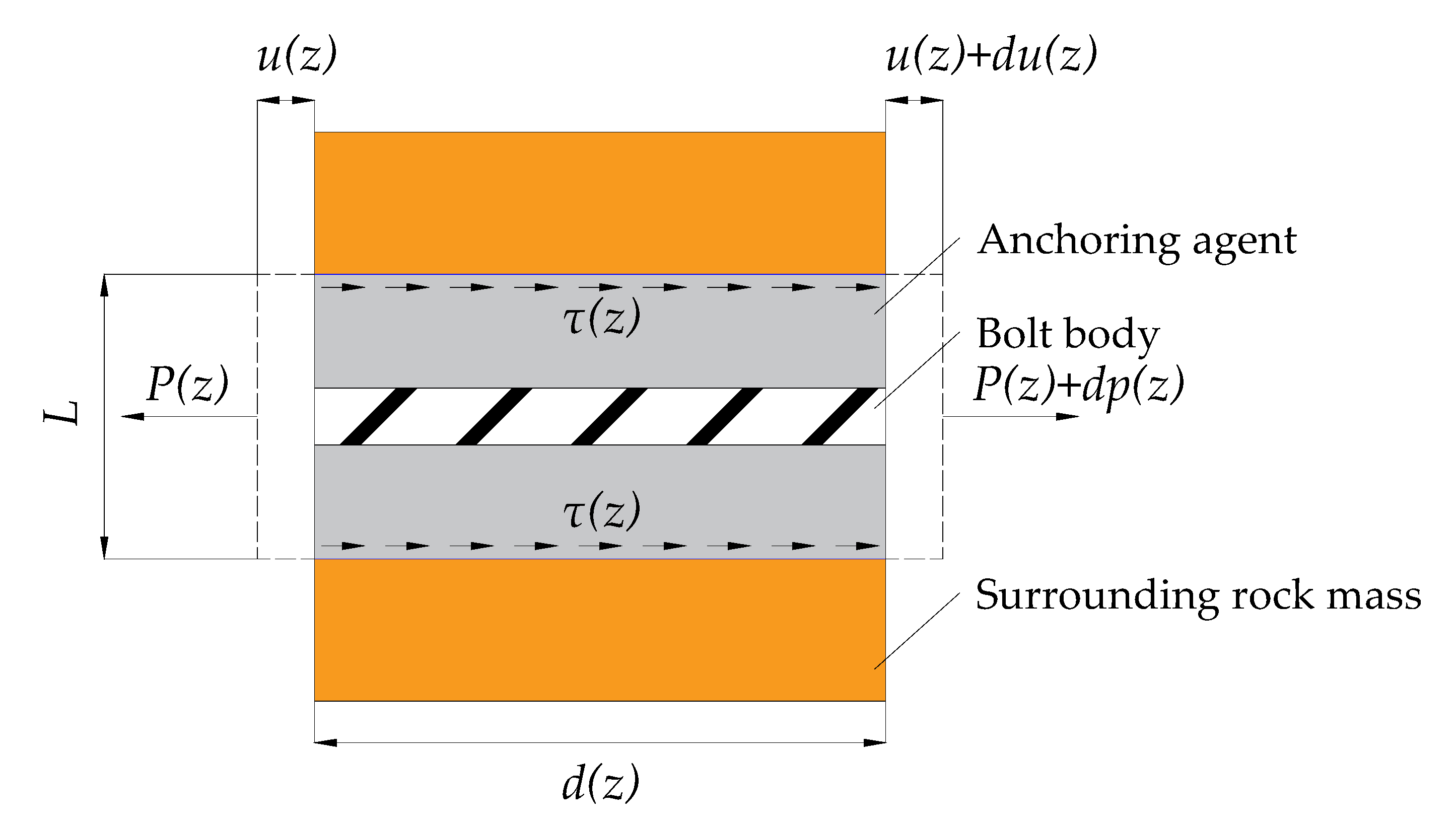
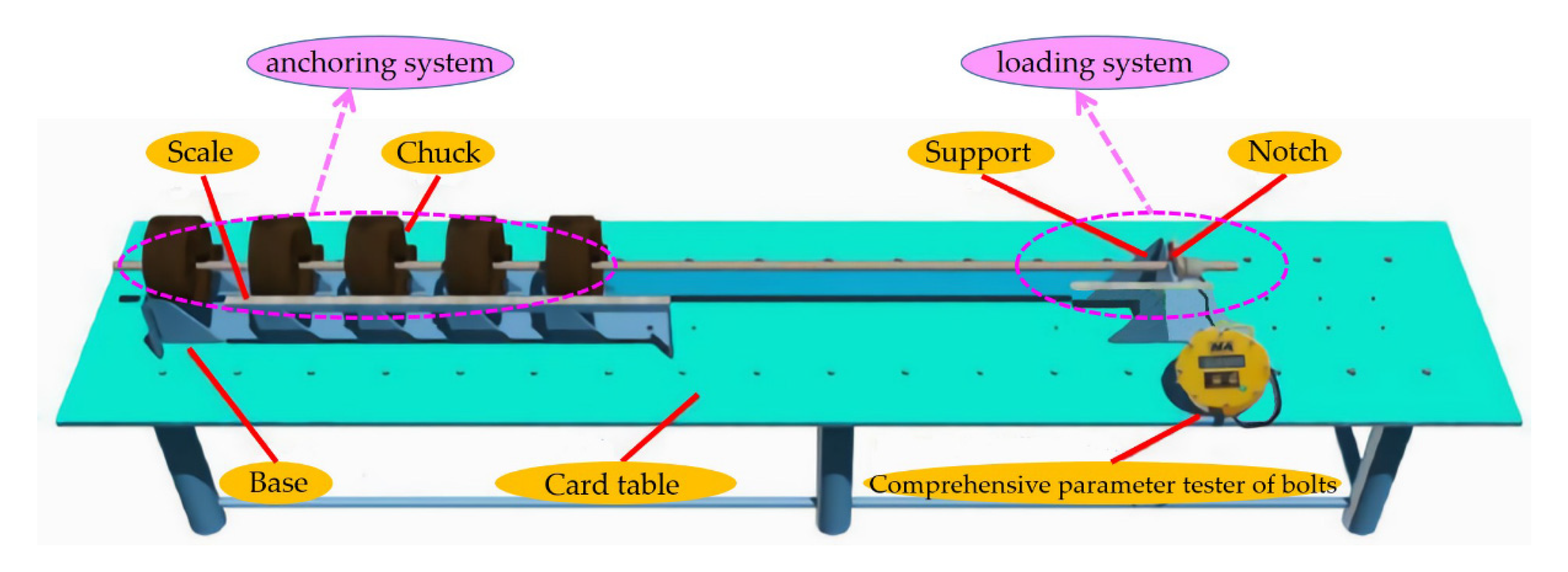
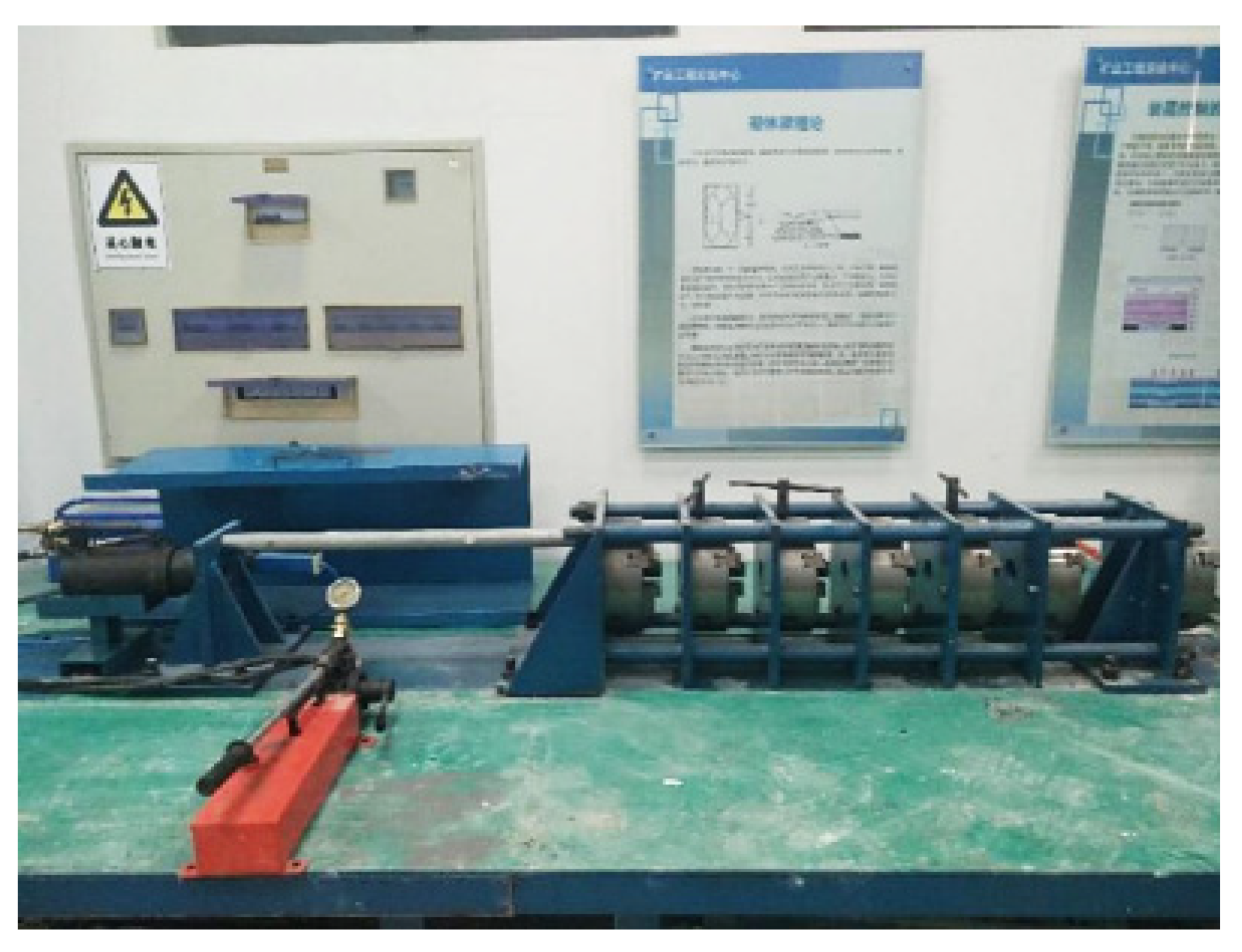


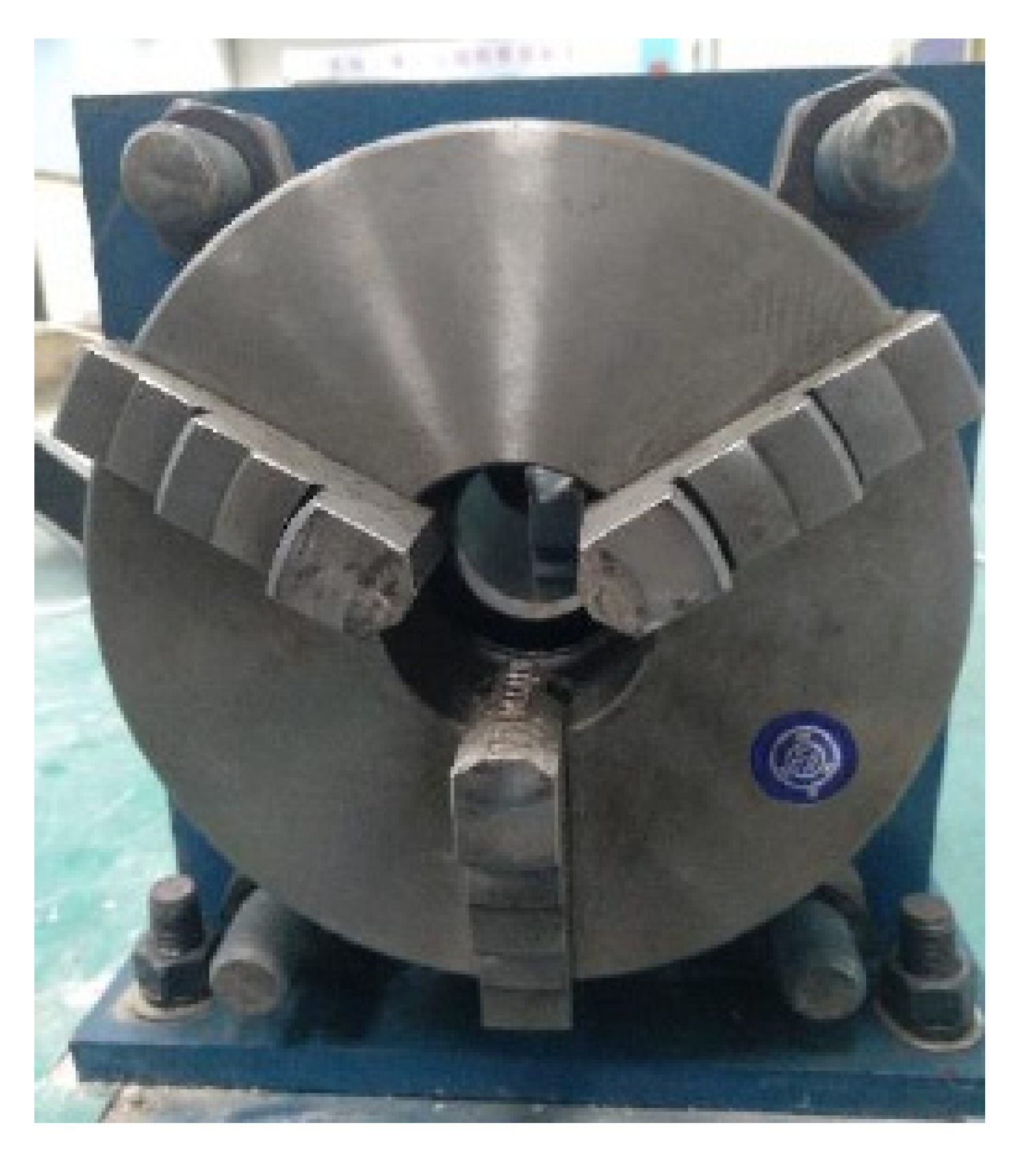

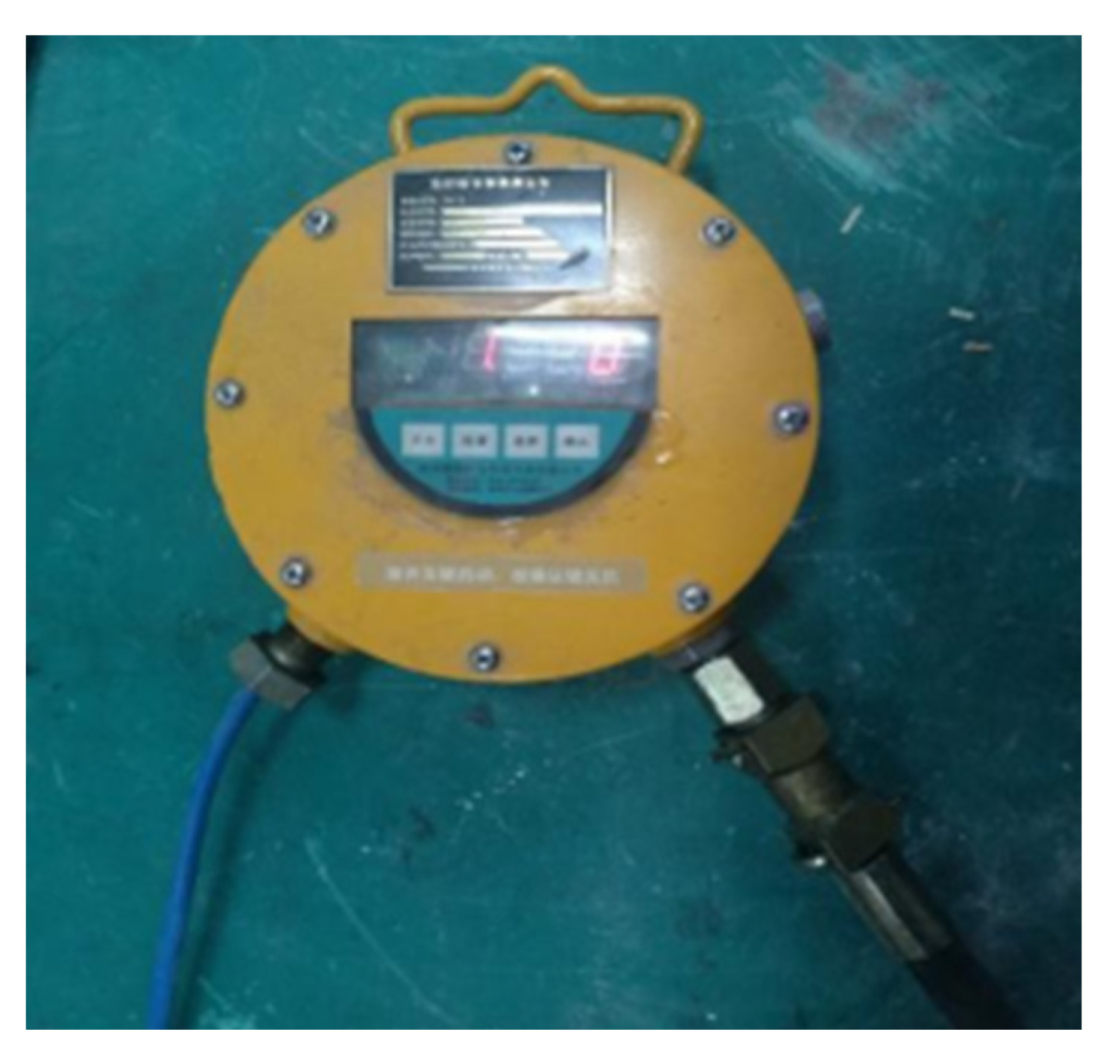



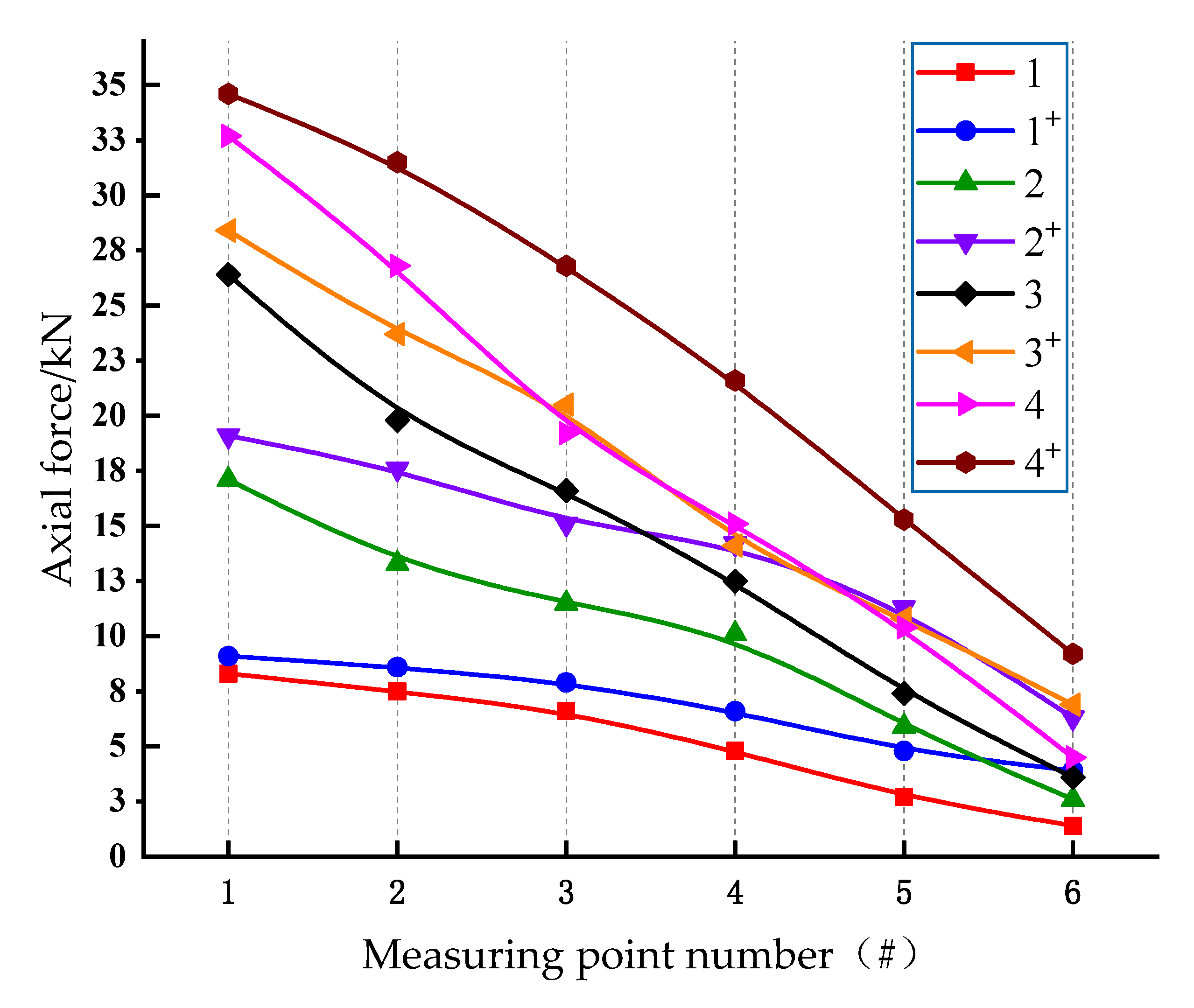
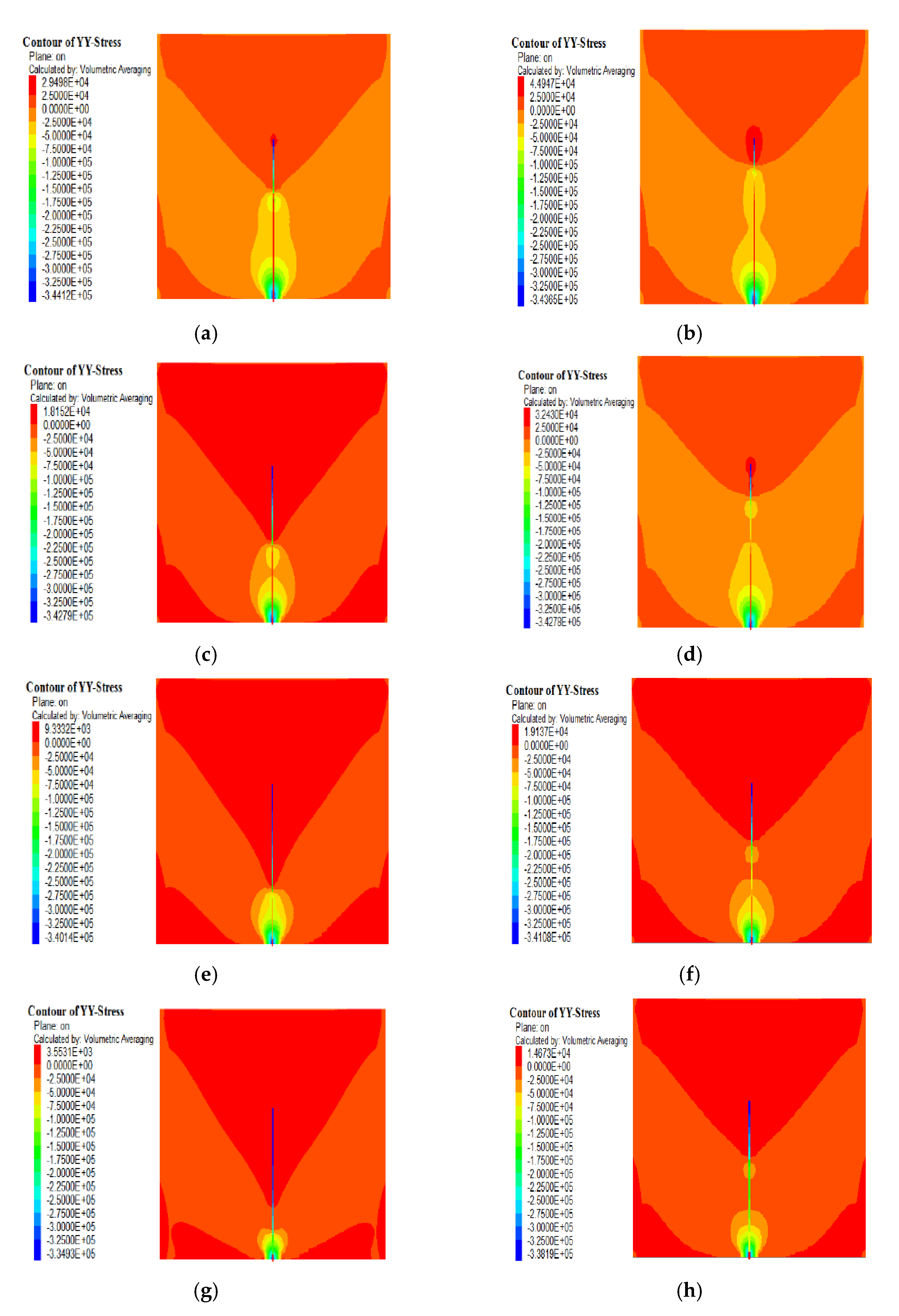
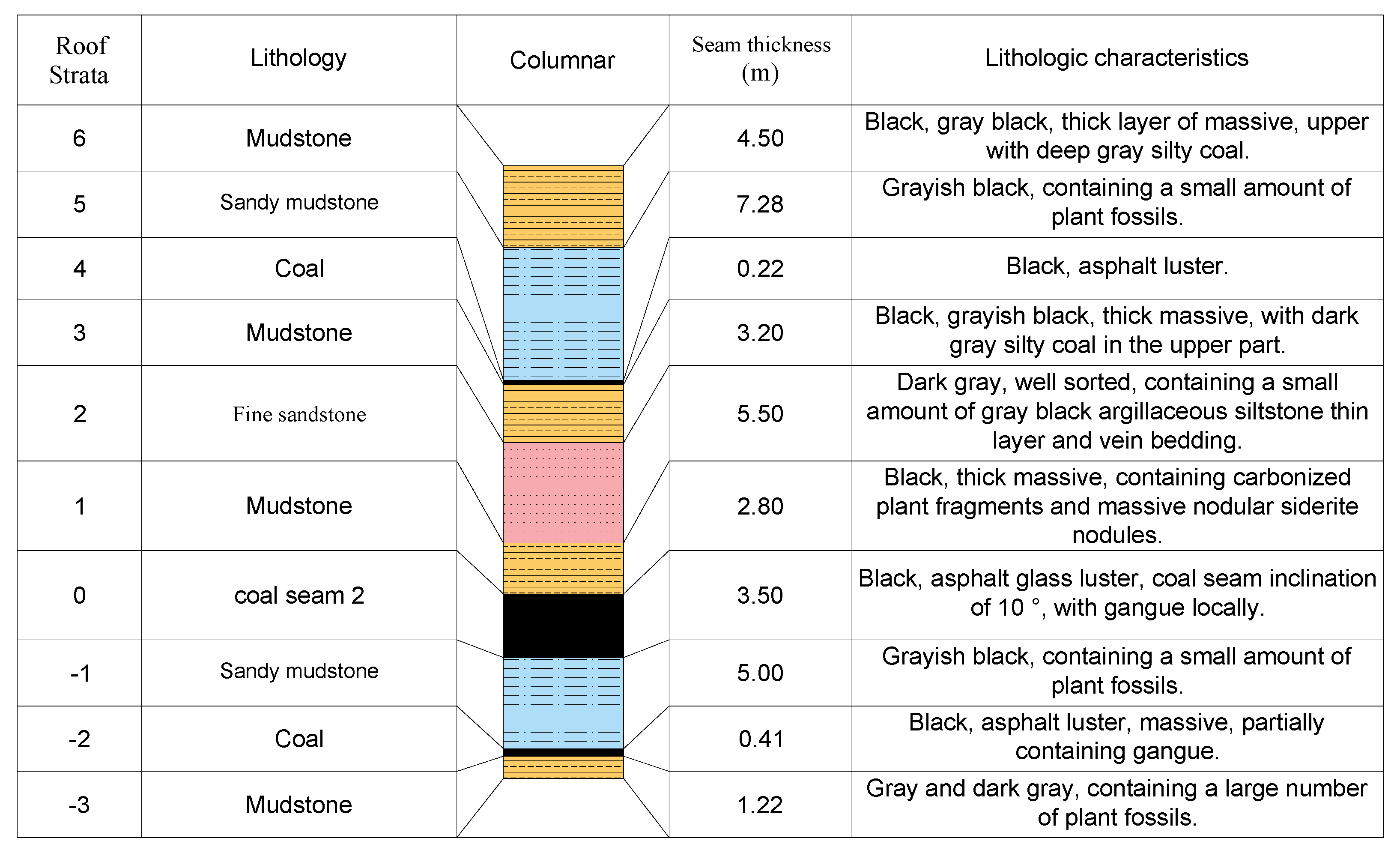

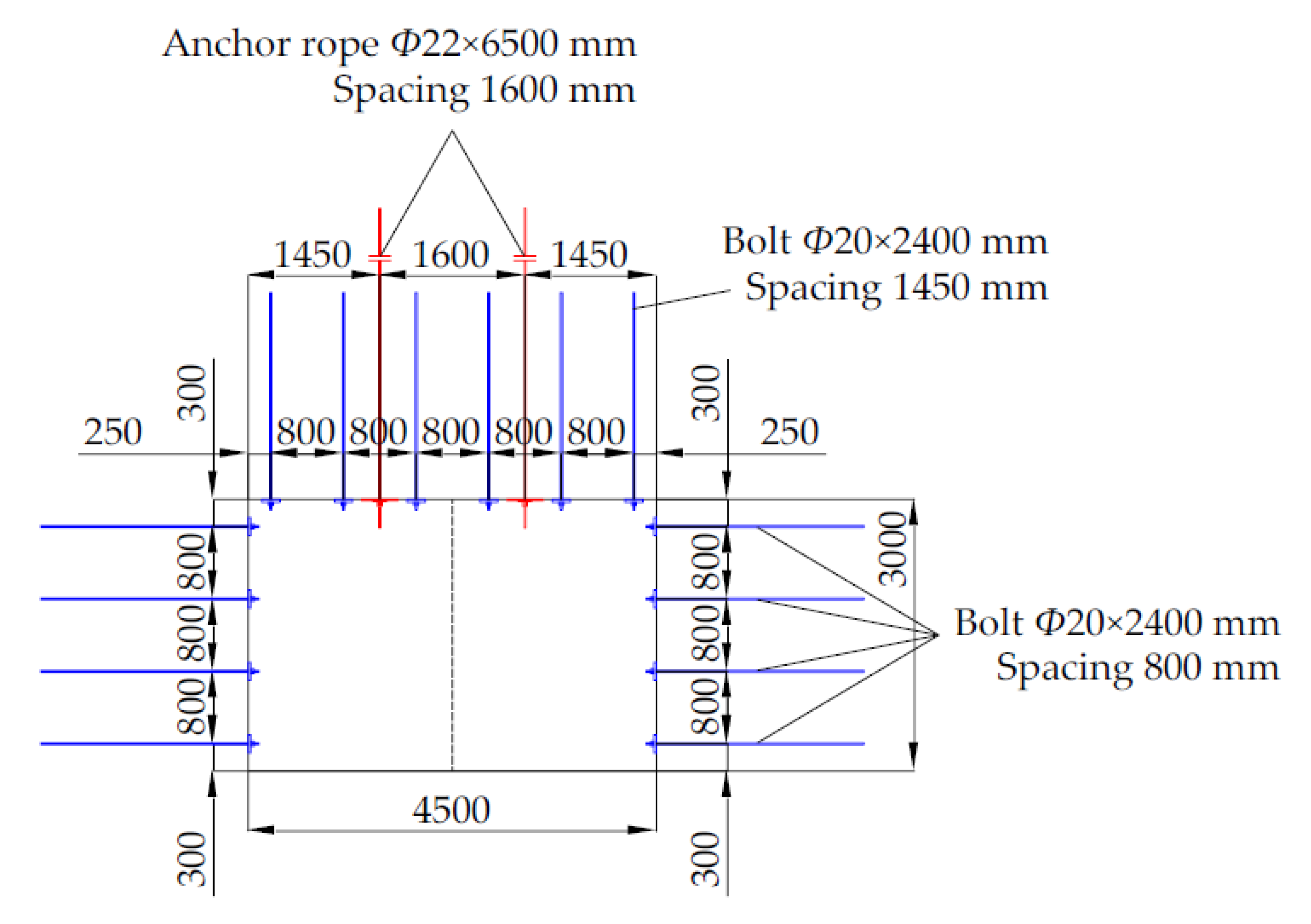
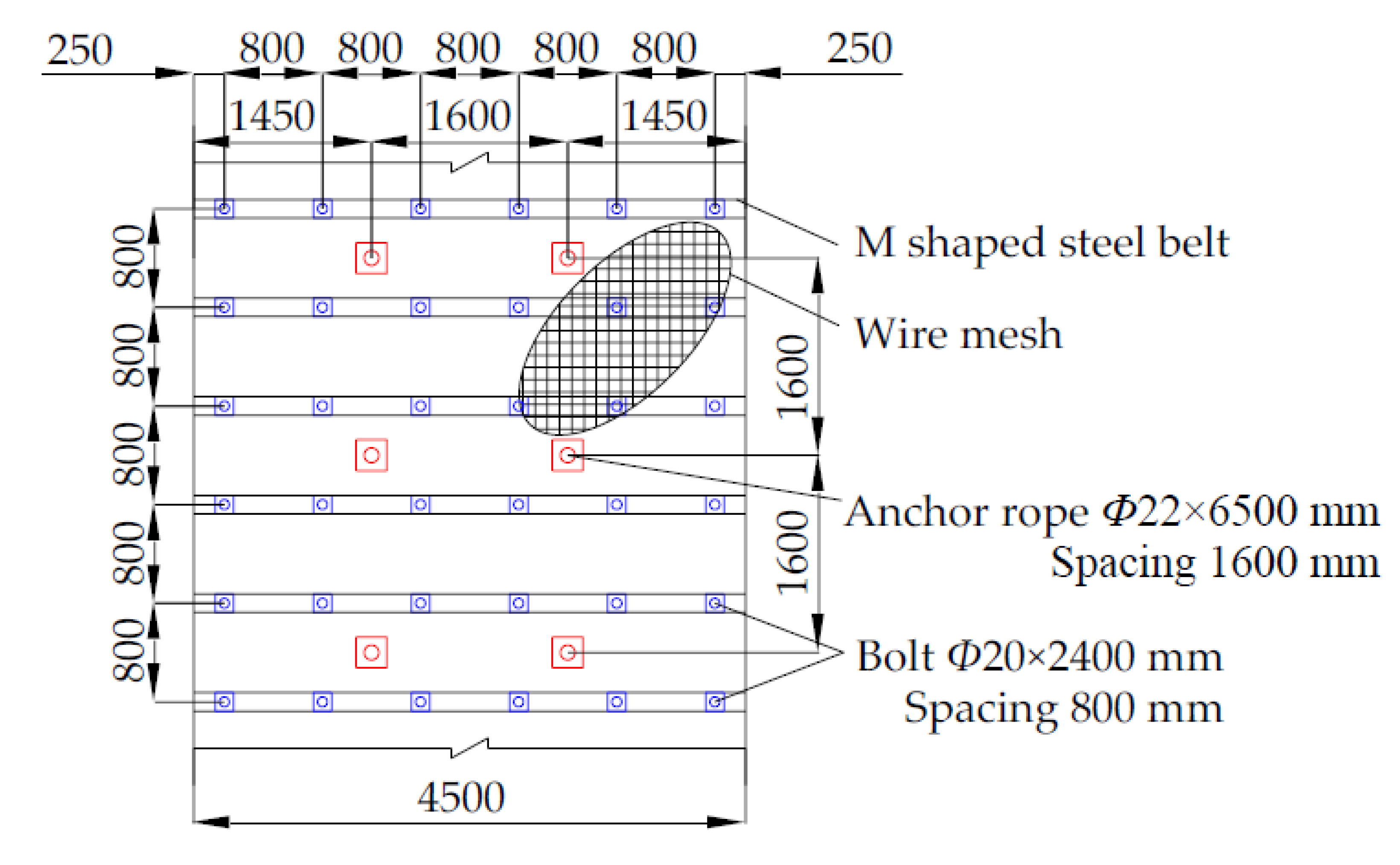
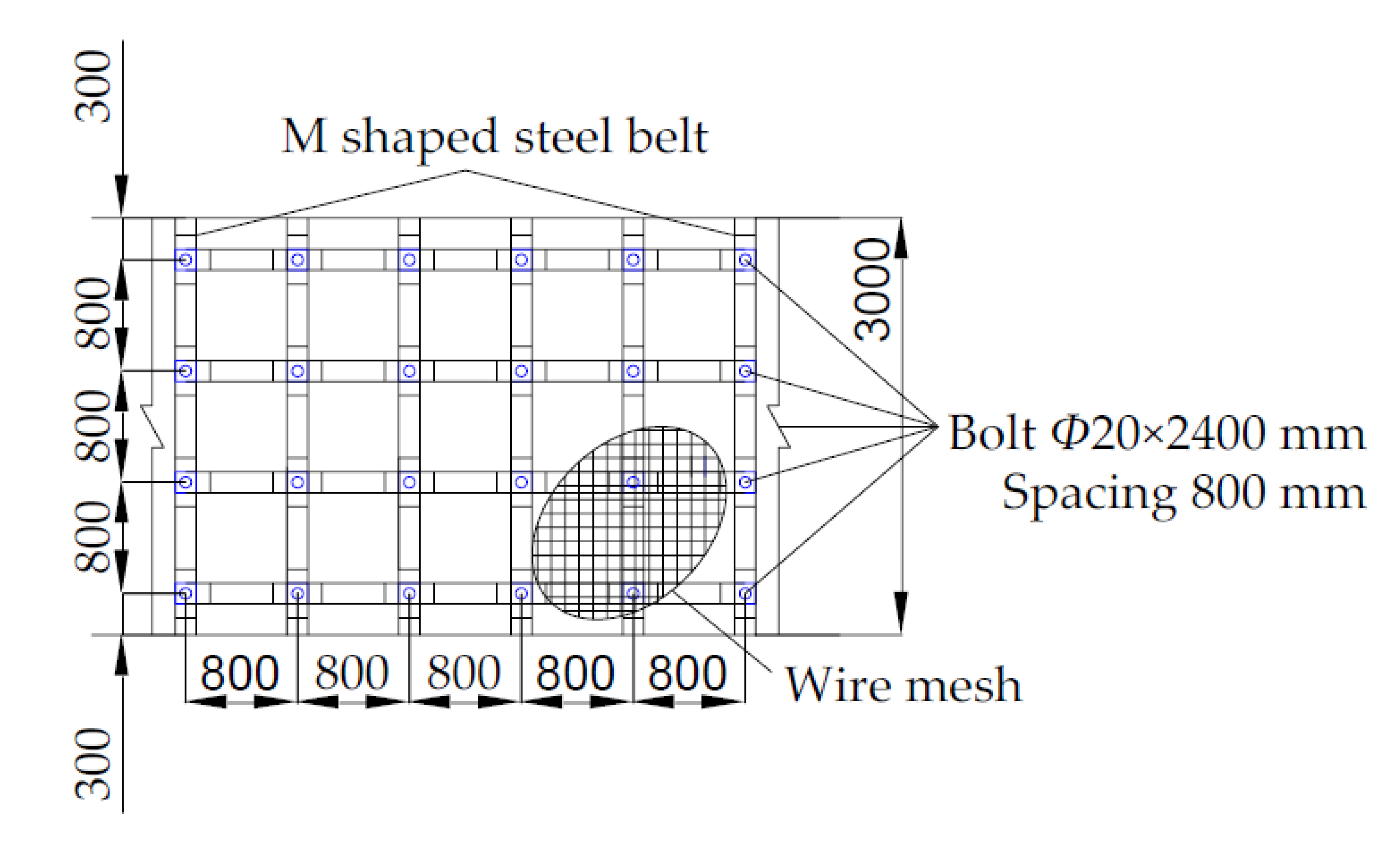

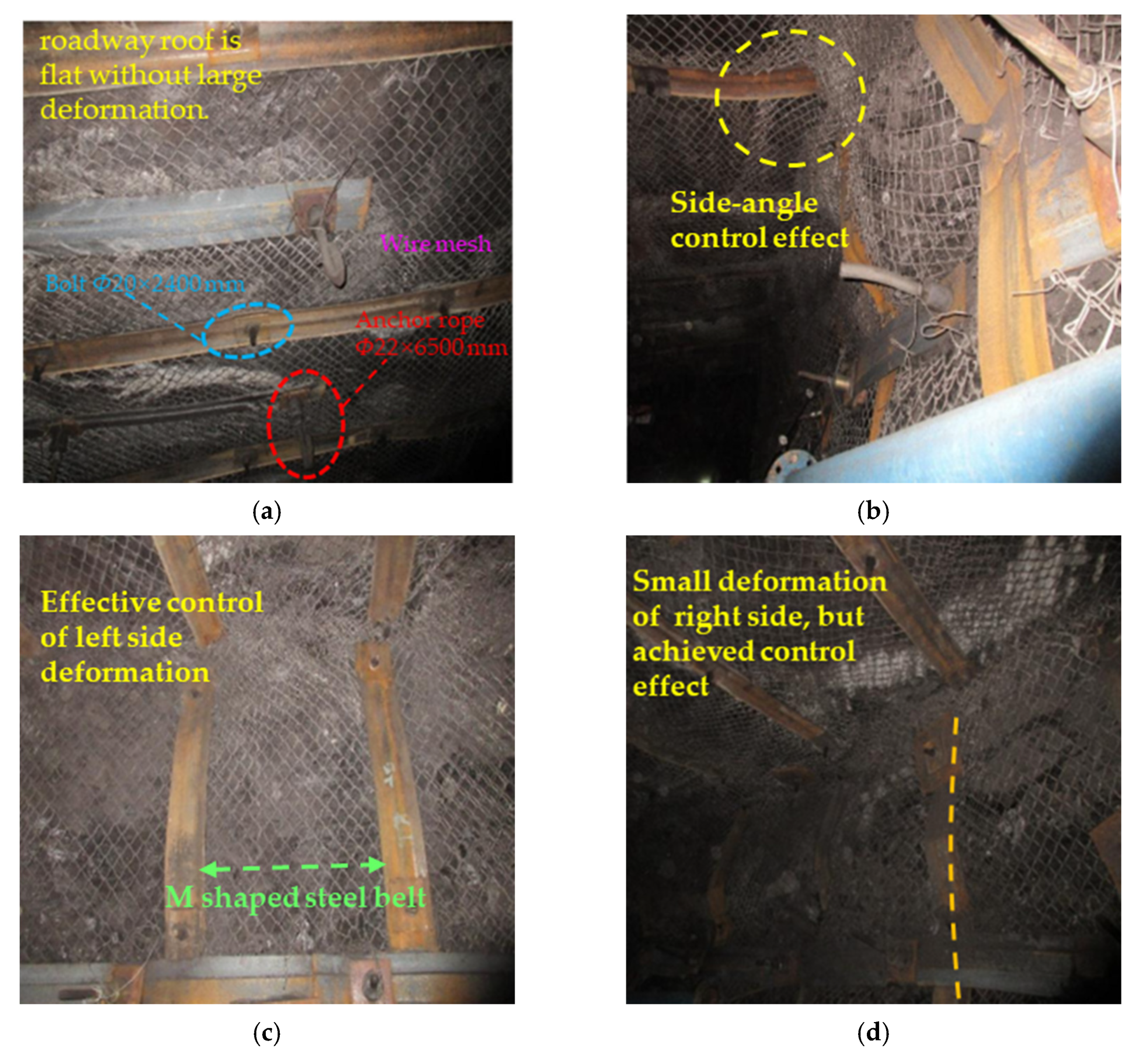
| Number of Measuring Points | Pre-Tightening Force (kN) | 10 | 20 | 30 | 40 | ||||
|---|---|---|---|---|---|---|---|---|---|
| Group | I | II | III | IV | |||||
| Bolt Serial Number | 1 | 1+ | 2 | 2+ | 3 | 3+ | 4 | 4+ | |
| 1# | Bolt Axial force (kN) | 8.3 | 9.1 | 17.1 | 19.1 | 26.4 | 28.4 | 32.7 | 34.6 |
| 2# | 7.5 | 8.6 | 13.3 | 17.6 | 19.8 | 23.7 | 26.8 | 31.5 | |
| 3# | 6.6 | 7.9 | 11.5 | 15.1 | 16.6 | 20.5 | 19.2 | 26.8 | |
| 4# | 4.8 | 6.6 | 10.1 | 14.2 | 12.5 | 14.1 | 15.1 | 21.6 | |
| 5# | 2.7 | 4.8 | 5.9 | 11.3 | 7.4 | 10.8 | 10.4 | 15.3 | |
| 6# | 1.4 | 3.9 | 2.6 | 6.3 | 3.6 | 6.9 | 4.5 | 9.2 | |
| Material Type | Cohesion | Internal Friction Angle | Strength of Extension | Yield Strength | Shear Modulus | Bulk Modulus | Bonding Strength | Compressive Strength |
|---|---|---|---|---|---|---|---|---|
| (MPa) | (°) | (MPa) | (MPa) | (GPa) | (GPa) | (MPa) | (MPa) | |
| Mudstone | 12.98 | 12 | 0.82 | 0.61 | 1.5 | 2.2 | / | / |
| CK2350 | 11.80 | 31 | / | 1.7 | / | / | 8.5 | 50 |
| K2370 | 11.20 | 28 | / | 1.9 | / | / | 9.3 | 55 |
| Bolt | / | / | 510 | 345 | / | / | / | / |
Publisher’s Note: MDPI stays neutral with regard to jurisdictional claims in published maps and institutional affiliations. |
© 2021 by the authors. Licensee MDPI, Basel, Switzerland. This article is an open access article distributed under the terms and conditions of the Creative Commons Attribution (CC BY) license (https://creativecommons.org/licenses/by/4.0/).
Share and Cite
Guo, X.; Zheng, X.; Li, P.; Lian, R.; Liu, C.; Shahani, N.M.; Wang, C.; Li, B.; Xu, W.; Lai, G. Full-Stress Anchoring Technology and Application of Bolts in the Coal Roadway. Energies 2021, 14, 7475. https://doi.org/10.3390/en14227475
Guo X, Zheng X, Li P, Lian R, Liu C, Shahani NM, Wang C, Li B, Xu W, Lai G. Full-Stress Anchoring Technology and Application of Bolts in the Coal Roadway. Energies. 2021; 14(22):7475. https://doi.org/10.3390/en14227475
Chicago/Turabian StyleGuo, Xiaowei, Xigui Zheng, Peng Li, Rui Lian, Cancan Liu, Niaz Muhammad Shahani, Cong Wang, Boyang Li, Wenjie Xu, and Guowei Lai. 2021. "Full-Stress Anchoring Technology and Application of Bolts in the Coal Roadway" Energies 14, no. 22: 7475. https://doi.org/10.3390/en14227475
APA StyleGuo, X., Zheng, X., Li, P., Lian, R., Liu, C., Shahani, N. M., Wang, C., Li, B., Xu, W., & Lai, G. (2021). Full-Stress Anchoring Technology and Application of Bolts in the Coal Roadway. Energies, 14(22), 7475. https://doi.org/10.3390/en14227475








